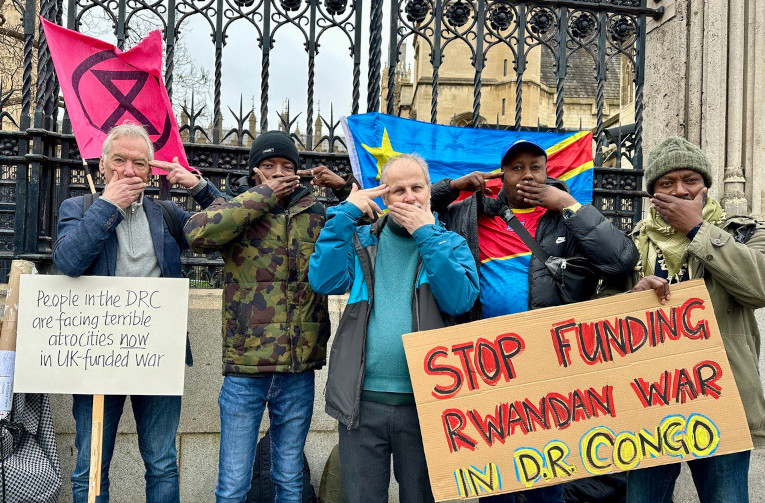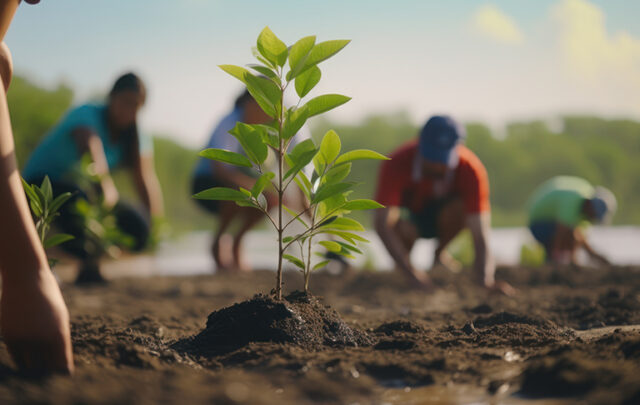As violent militias rampage across the country, activists in the DRC are urgently calling for a green transition that puts justice first, not new revenue streams, and that dismantles colonial exploitation once and for all.
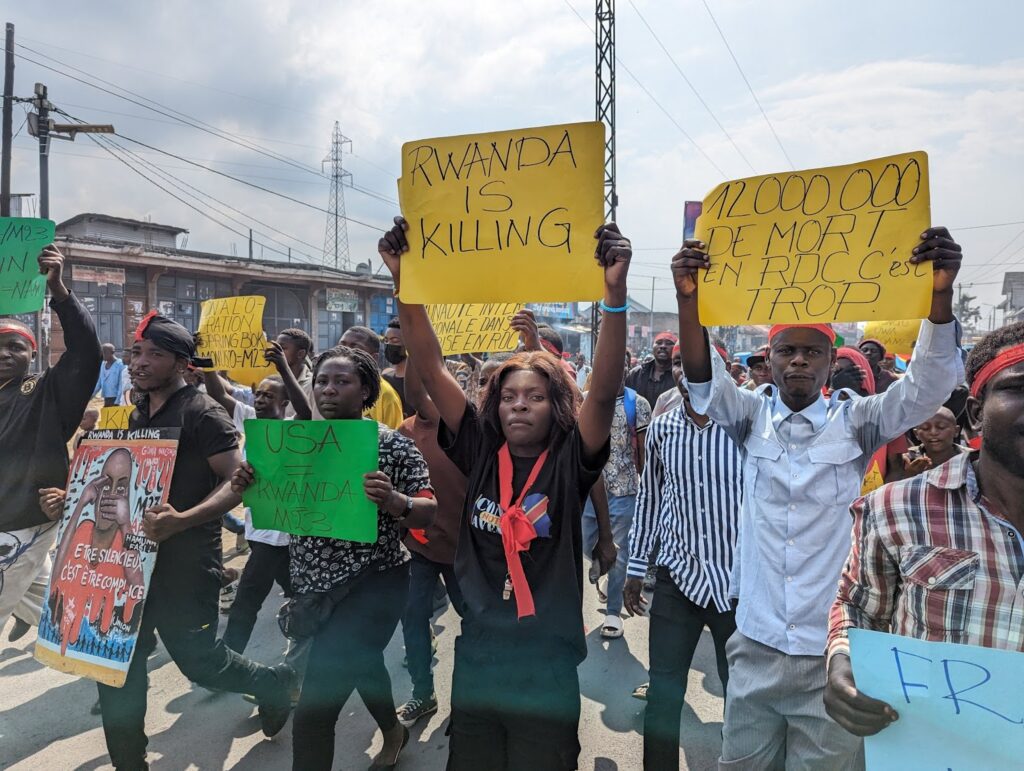
Activists in Goma denounce state and international inaction after savage attacks by a Rwandan-backed militia. Photo: LuchaCongo.org
“Inside every phone is the blood of a Congolese person.” These words from Pascal Mirindi, a student and activist in Goma, Democratic Republic of Congo (DRC), encapsulate the deadly links between war, the plunder of resources, and climate breakdown.
Nowhere is this more devastatingly clear than in the DRC, where M23 militias financed by the Rwandan government, which is in turn funded by the UK, USA, and many more, are committing mass murder and ecological destruction as they surge into the east of the country.
On the rare occasion that the mainstream media covers the DRC, it is portrayed as a poor nation with a “complicated” conflict-riven backstory. But this framing omits the catalyst for the region’s violence since its colonization – resource robbery.
“The conflict, which has persisted in the east of the DRC for almost 30 years, and is the deadliest since the Second World War, is mainly economic,” explains Nobel Laureate Dr. Denis Mukwege. Since 1996, more than 10 million people have been killed, with countless more being displaced, raped, or forcibly recruited (even as children) into armed groups. “The link between exploitation and the illegal trade in minerals is recognized as a root cause.”
Rich nation, poor nation
The current fighting has now displaced more than 10 million people, triggering another wave of indiscriminate killings, mass rape, and disease, while militia armies ransack the country’s rainforests with illegal logging and poaching.
Though the Congolese people have long been vampirized by extractivism, with over 70% living on less than $1.90/day, the DRC is not a poor nation – it is a robbed nation. In fact, the DRC is considered the world’s richest country in terms of wealth in natural resources.
DRC’s fossil fuels have been profitably exploited by foreign corporations and co-opted local elites for decades, leaving communities like Muanda, which is uncoincidentally both the original site of fossil fuel extraction and the poorest city in the country, scarred by dispossession, disease, and environmental degradation.
After the deadly Kalehe flood in South Kivu province last May, which killed hundreds and affected another 50,000 people in the flood zone, student activists from Extinction Rebellion Goma University launched the Pétrole Non Merci campaign in order to highlight that the DRC is already suffering the effects of climate catastrophes and that this suffering will only increase if the fossil fuel industry’s expansion is not stopped.
The students traveled thousands of miles across the width of the country, mobilizing communities to oppose the sale of 30 new oil and gas blocks, most of which overlap protected areas and would be transported by the ecocidal EACOP pipeline. A major focus of their efforts has been to facilitate ongoing educational exchanges on how to claim their rights through nonviolence and to hold officials and corporations accountable to local communities.
The continued work of building grassroots power to counter resource and human exploitation is now facing crucible conditions. Goma activists are spending long hours caring for the massive influx of internally displaced people amid food shortages and cholera outbreaks. Others in their networks have been displaced and suffered violence and even death. “This crisis only reinforces that the struggle for environmental justice is inextricably linked to the struggle against the cycles of violence that we continue to experience,” explains an activist with LUCHA, a non-violent and non-partisan youth civil society movement in Goma.
Green growth, red trail
As global finance gears up for “green growth”, the DRC’s resource wealth has again brought violence, robbery, and ecological destruction. The world’s largest coltan reserves, vast caches of copper, diamonds, tin, gold, and more than 63% of global cobalt are prized by armed gangs who sell them to corporations and wealthy states wanting to manufacture phones, computers, batteries and increasingly, renewable energy technologies.
In the chaos orchestrated by the militias, minerals are more easily siphoned to Rwanda, where they are exported and bought by multinational firms like Glencore. Nicolas Kazadi, DRC’s finance minister, claims that Rwandan mineral smuggling costs the DRC $1bn per year. The US Treasury estimated that last year more than 90% of DRC’s gold was smuggled to countries including Rwanda and Uganda, where it is refined and exported, mainly to the United Arab Emirates. Rwanda is also somehow the world’s primary exporter of coltan, despite being one of the lowest mineral producers in Africa. Without conflict minerals, the numbers just don’t add up.
Efforts to regulate conflict minerals and ensure responsible supply chains have been laughable in their inadequacy, and typical in their market-oriented approach that prioritizes profits while ignoring Congolese perspectives and outcomes. “The case of conflict minerals poses questions about how global supply chain capitalism, conflict resolution, and consumer ethics intersect with postcolonial friction and violence,” writes Josaphat Musamba and Christoph Vogel in Dissent Magazine. “Both international and Congolese interveners and elites have contributed to simplistic and misleading imageries of the problem and its solution, in a quest for a quick and seemingly hands-on, human rights–inspired PR operation.”
Until a decolonized approach that centers communities and ecology is adopted, extraction will inevitably lead to conflict. It is not possible to clean up a supply chain that begins with dirty motives, just as it is not possible to build regional stability and heal generations of trauma in the context of manipulation and structural inequity, better known as ‘development and aid’.
Donor darling, donor orphan
Though this long regional conflict is often portrayed as Rwandans vs Congolese, Hutu vs Tutsi, or even Muslim vs Christian, the primary generator of endless suffering is a more universal clash – power and profit vs people and planet. Colonialism never really ended, it simply now works remotely via economic imperialism. A look at the history of foreign intervention in the region clearly shows that the sources of underlying tensions, that have so far been inescapable, are not due to some inherent failing of Congolese or Rwandan people – it’s structural.
“Several studies point to the erroneous perceptions of outsiders to explain why their interventions have been unable to address the root causes of conflict in the African Great Lakes region. However, few authors focus on the impact of UN and donor activities on regional fragility,” says policy analyst Léopold Ghins at the Firoz Lalji Institute for Africa. “It is chiefly through these activities that outsiders have become part of the problem they [supposedly] seek to resolve.”
One way in which the imperial core exacerbates regional fragility is through unbalanced aid allocations. From 2003-16, Rwanda received about 130% and 50% more aid in per capita terms than the DRC and Burundi respectively. Rwanda was dubbed a ‘donor darling’, while the DRC and Burundi were considered ‘donor orphans’.
Donors now see Rwanda as a useful regional hegemon through which to carry on with the plunder of African resources. Its economy is growing, its infrastructure is developing at speed, and yet this celebrated growth has only benefitted a tiny elite.
It’s necessary to look up from the accounting books, step out of the board room and into the streets to take notice, but if Rwandans are so happy with their “development success”, why is there a black-clad, machine-gun toting policeman on every second street corner in Kigali? Over the last 24 years under President Kagame, the government has become unashamedly authoritarian with mounting human rights abuses.
Unhoused Rwandans and those caught begging have been forcibly exiled to a “rehabilitation island” in the middle of Lake Kivu, also known as Rwanda’s Alcatraz. Dozens of journalists have been banned from the country, arrested, and killed. Opposition politicians are routinely locked up, while civil society groups are not allowed to operate independently. Rwanda’s involvement in the destabilization of the DRC, the plundering of its resources, and the commission of the most serious crimes, including the use of sexual violence as a method of war and as a strategy of terror, is widely documented, notably by the United Nations.
Yet this outcome is touted a development success as the EU and other international institutions cozy up to Kigali for more business as usual, even striking a high-profile advertising deal with FC Arsenal where players wear a “Visit Rwanda” slogan on their jerseys. Sure, visit Rwanda – but only if you don’t plan on asking too many questions and steer clear of the military’s infamous detention and torture camps (whose existence is denied by the government). They will really ruin your holiday.
Again, activists seem to be doing better investigative journalism than the mainstream media, and are not fooled by spectacle. In a recent solidarity action both outside and inside the UK’s Parliament, activists from Extinction Rebellion UK denounced their government for giving Rwanda vast sums to service its extreme asylum policies, and therefore indirectly enabling mass violence and the theft of $24 trillion in natural resources from the DRC.
Zoom in, zoom out
The closer you look, the more you see when it comes to the ripple effects of foreign intervention – but out of the complexity, a clear pattern of disregard and disrespect emerges to untangle the mess.
For example, a second by-product of donor policies is the core-periphery structure that has emerged in the Great Lakes. At the core is the Kigali-Kampala axis, with eastern DRC, Burundi, and North-Western Uganda together forming the periphery. Mirroring global relations, people living in the regional core face lower security risks and have higher incomes in comparison to those in the periphery. “This situation has entrenched the notion that areas in the periphery are ‘lagging behind’, and reinforces perceptions of the DRC as ‘an inscrutable and unimprovable mess’,” explains Ghins.
If we turn from development to peacekeeping, the effects of MONUSCO (Mission des Nations Unies pour la Stabilisation en République démocratique du Congo) were yet another channel through which outsiders aggravated regional fragility. With a budget of $1.5bn a year, and employing 20,000 uniformed staff, the UN peacekeeping force was the largest mission in the organization’s history. Yet, over its 14+ years in the DRC, it was infamous for protection failures and struggled for credibility.
Of course, 20,000 staff can’t exist in a vacuum. The presence of large numbers of UN personnel in cities like Goma created dual labor markets for service sector jobs like cooks, cleaners and drivers. High expatriate salaries led real estate prices to soar. Yes, billions of dollars were spent on “peacekeeping”, but it was not guided by affected communities and could not be responsive to their needs. Ghins describes the outcome: “Not only did MONUSCO divert resources away from productive foreign investments in the Congolese economy, but it distorted local markets and may have impeded on the kinds of ‘autonomous recovery’ processes that conflicts are sometimes found to induce.”
Today, we are witnessing the eruptions that have been kept simmering, waiting for ignition, in no small part by a paradigm of imposed peacekeeping which is ineffective at community-driven peacebuilding. Relying on MONUSCO, Kinshasa had limited incentives to expand its own military capacity in the east. By protecting the main urban centers, MONUSCO bases mostly prevented any armed group from overpowering others. “Even if the UN mission played an essential role in civilian protection, it also ‘condemned’ myriad rebel formations to coexist indefinitely,” says Ghins. A 2019 independent strategic review of MONUSCO agreed that the military aspect of the peacekeeping mission had come to overshadow its civilian and political components. The political process to demobilize and negotiate with armed groups had, in actuality, been stuck for several years.
As MONUSCO’s presence has come to a close, it is this lack of community focused peacebuilding which is being exploited for profit by President Kagame and other local elites who use a combination of hate speech, scarcity, and fear to ignite passions on their behalf. The international community, or more specifically the imperial core, seems to find the situation amenable to an easy flow of cheap and minimally regulated resources. A united region that could leverage its own collective power over the largest trove of natural resources on the planet, would be far less convenient.
Over thousands of pages, a complex and detailed analysis of policy would reveal something fundamentally wrong with a development model that benefits a tiny few at the expense of most, while ravaging ecosystems. But, this structural error is equally apparent via a handful of case studies – and perhaps is less likely to get lost in the details. Over the decades, a series of top-down imposed “solutions”, whether in the name of peace or development, were consistently unaccountable to and unrepresentative of the actual communities at which they were aimed. They never failed to do more harm than good.
First justice, justice first
Whether a political economy of war was intentionally arranged, a result of good intentions but ill-conceived policy, or a combination of both – it clearly exposes a structure that has driven endless conflict. Underlying racism and the blanket pursuit of growth to fuel profits, regardless of social and ecological costs, created this context and continues its reproduction.
“We see the height of cynicism in terms of geostrategy and a policy of double standards,” says Mirindi in Goma. “We see what is happening in Ukraine, what is happening in Gaza. Why not, what is happening in the DRC? Why aren’t there sanctions against Rwanda which officially, visibly, supports these militias?”
The security and humanitarian situation is becoming more and more dire each day.
Clashes have intensified in recent days between M23 and Congolese government forces in the territories surrounding Goma, the regional capital home to over a million people. Goma airport was bombed twice. Internally displaced people continue to arrive in droves.
On his way back to one of the crowded refugee camps on the outskirts of the city, Mirindi describes an outbreak of a skin infection that is spreading like wildfire among the displaced children. He is seeking a way to organize medical aid, though he is not a doctor. Out of a resilience born both of necessity and of vision, he and fellow activists, artists, students, and friends are experienced in organizing as a practice of strategy as well as care, yet stress is taking its toll.
In between patient explanations of history, context, corruption, and atrocities, snippets of existential concern very near at hand slip into focus: “Last night and again today it has become more complicated with the security situation.” And, “The price of food has almost tripled in Goma. We fear that this will continue because all of the surrounding territories and villages that produce food for the city are under M23 control and the population has fled.” Heartwrenchingly, “Young children are dying of dehydration from cholera.” Yet in every conversation, we inevitably return to ordinary people aiding one another in extraordinary ways – the makings of a paradise built in hell.
Speak truth, act now
From this brutal context, activists in the DRC are calling for the international community to immediately stop funding Rwanda’s aggression and to hold all who are complicit accountable. Refusing to abandon their right to a future, they are urgently calling for a green transition that puts justice first, not new revenue streams, and that dismantles colonial exploitation once and for all. “Otherwise,” warns Dr. Mukwege, “the so-called green energy transition will remain red with the blood of Congolese men, women, and children” – collateral damage to enrich the same old racist elites.
In a silent protest in February, DRC soccer players stood before their Africa Cup of Nations semi-final match against Ivory Coast. They chose not to sing their national anthem, opting instead to cover their mouths with their hands and place two fingers from their left hands to their temples, a display of unity and solidarity with all Congolese people – silenced, with a gun to their heads.
This hand gesture is not a resignation, it is condemnation and a challenge. The DRC will no longer be silenced. When asked for the first step towards solidarity, Mirindi urges that, “It is really essential that we talk about this situation again and again, to attract the attention of the international community, organizations, public figures and to have more mobilization. If we can continue like this… that way, it will be better.”
[Goma Actif is organizing a fund drive ‘SOS Congo’ to help support displaced people.]
Bosembo by Ben Kamuntu & Ben Man
This powerful music video by members of Goma Slam Session, a collective of young poets and rappers from the DRC, is part of a campaign to seek justice for the crimes committed in the country from 1993 to date, including those documented in the UN Congo Mapping Project report.
Bosembo translates as: justice, truth, peace, right, impartiality, fairness, objectivity, honesty, serenity, tranquility, and goodness.
Goma’s youth continues to be a powerhouse of creativity and resilience, proving that art can be one of the viable alternative strategies that activists can use to organize, communicate, mobilize and influence.
The author would like to recognize activists from XR Goma University, LUCHA RDC, and XR Global Support for their contributions to this article and for their struggle for environmental and social justice.
Original quotations were translated from French by the author.

On International Women’s Day, Congolese activists in the city of Beni demand justice for the women suffering violence in DRC. Photo: @luchaRDC
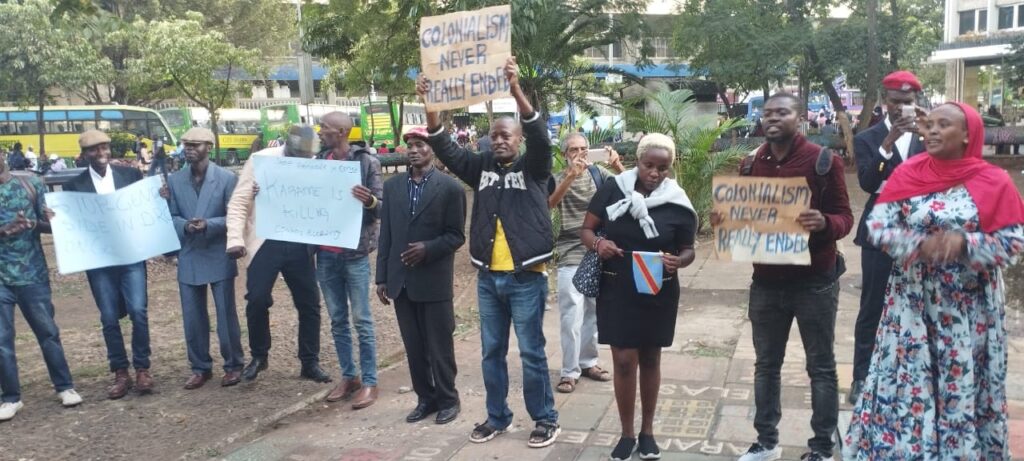
A rally in Nairobi, Kenya calls out Rwandan aggression in DRC. Photo: @luchaRDC
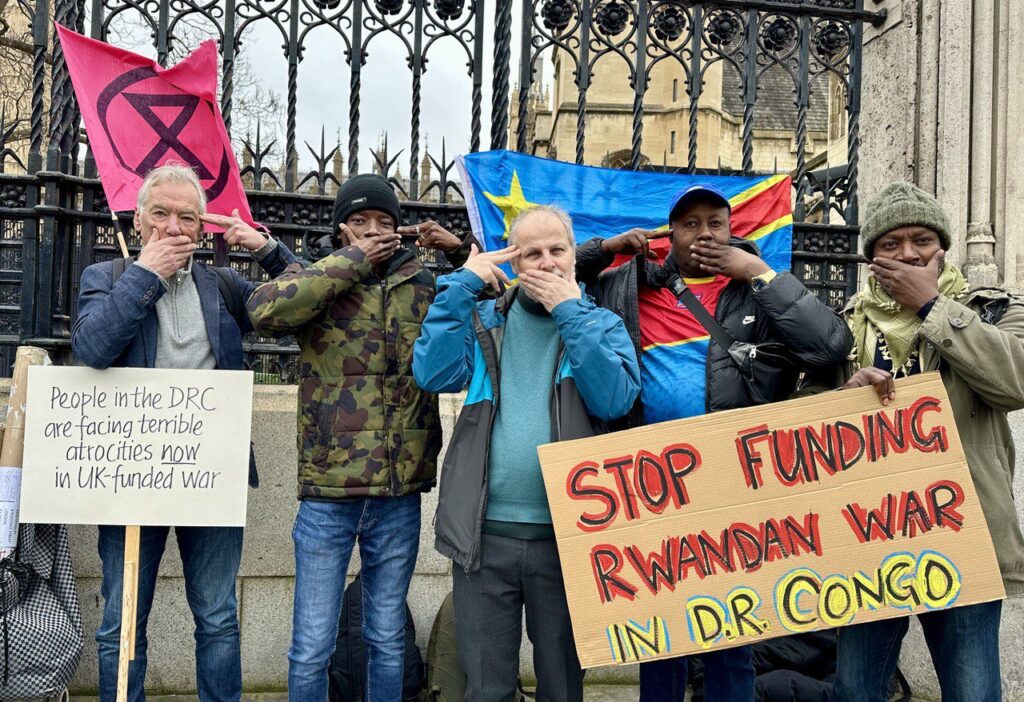
XR activists outside the UK Parliament protest the financing of violence in the DRC. The hand gesture, used by Congolese protesters to call out inaction of international and regional powers, represents being silenced with a gun to your head. Photo: @XRebellionUK
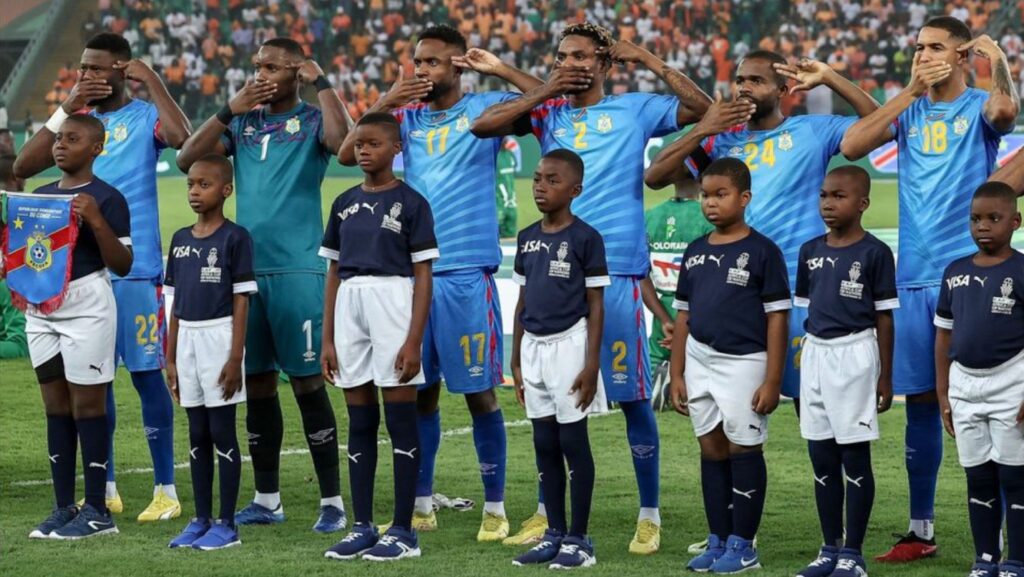
Democratic Republic of Congo players silently protested before their AFCON semi-final match against Ivory Coast. Photo: @fecofootcg


